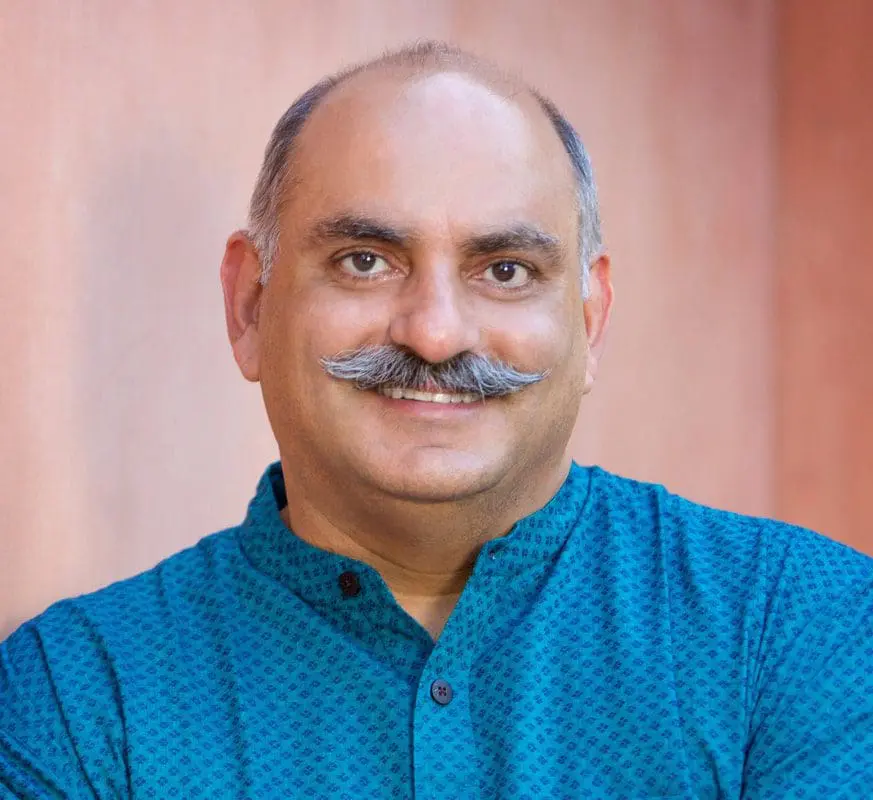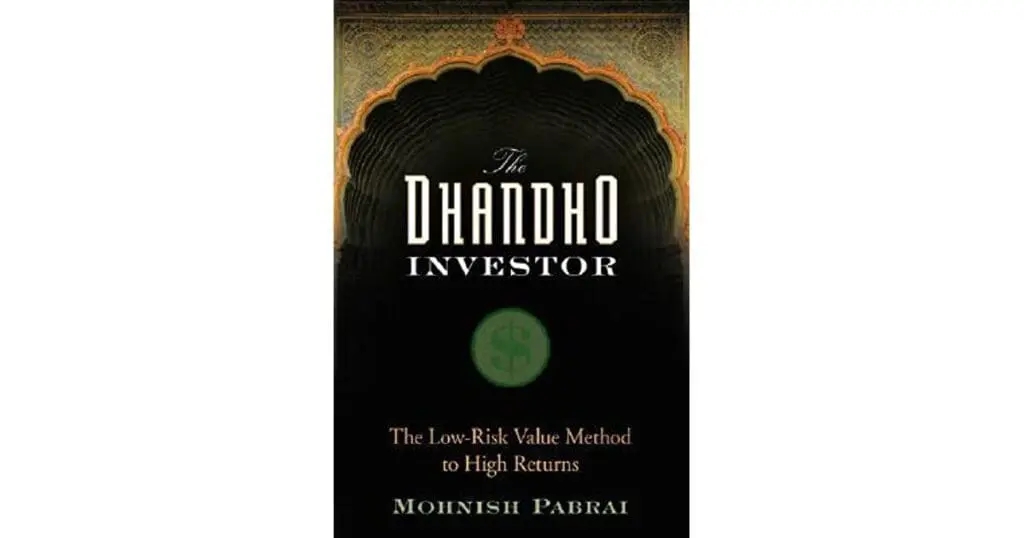Most people avoid investing because they fear making a bad investment and losing their savings. In The Dhandho Investor: The Low-Risk Value Method to High Returns, Mohnish Pabrai urges us to abandon risk completely and offers a simple way for a traditional investor to build wealth.
Contents:
Who Is Mohnish Pabrai?

Pabrai is an Indian-American value investor and founder of Pabrai Investment Funds and Dhandho Funds. In investing, he is known for openly acknowledging borrowing from the strategies of legendary investors like Warren Buffett and Charlie Munger, famously calling himself a “shameless copycat.”
His systematic research gives him an uncanny ability to spot companies with huge potential. Once invested, he sticks to them even in tough times, showing the conviction of his decisions. Pabrai is known for focusing clearly on his goals while maintaining his demeanour. He has built a reputation as a legendary value investor of our generation.
Apart from investing, Pabrai believes in returning to society. He founded the Dakshana Foundation, which helps underprivileged students in India get a world-class education. Much like his investment philosophy, his philanthropic philosophy is about maximising value in people’s lives. He’s investing in people, betting these students can achieve great things with the proper support.
What Exactly Is the Dhandho Investor Approach?
Dhandho” street translation means “business” in Gujarati, and in a literal sense, it means “endeavours that create wealth.” But Mohnish Pabrai takes on a narrower meaning, explaining his low-risk, high-return approach to business. He calls such bets as, “Heads, I win; tails, I don’t lose much.”
Dhandho is a very conservative and low-risk investment philosophy. Its first goal is to conserve wealth and then grow by finding stocks and companies where you can limit your losses but give yourself a good chance to profit by buying them below their fair price.
The Key Principles of Dhandho Investing

Pabrai’s investing style is based on a few guiding principles that other investors can apply to their investments:
- Invest in Troubled Industries: When a whole industry is down, Pabrai sees his chance to buy stocks. It’s like finding treasure when everyone else looks away. While others are selling, he buys stocks for less than their worth.
- Find the Margin of Safety: Pabrai insists on a “margin of safety.” This just means buying stocks at a discounted price so you have a cushion in case things go wrong. Legendary investors like Graham and Buffett have always done this. Think of it as a seatbelt—you don’t need it until things get bumpy. Having that backup gives you peace of mind.
- Invest in businesses with a Durable Moat: These companies have a special competitive edge no one else has. It’s like a castle with a mote around it—it’s hard for enemies (or competitors) to attack. These businesses grow successfully for years because they have an edge others can’t match.
- Focus on Simplicity: Invest in straightforward businesses without complicating things. Pabrai says to stick to companies that are simple to understand. You don’t need to be an expert at spotting good companies. Just focus on basic businesses you understand.
- Copy the Best: Don’t reinvent the wheel. Pabrai suggests following the lead of the greats, like Warren Buffett. Instead of trying to come up with something new, he “shamelessly” copies strategies that have worked for others. If it worked for them, why wouldn’t it work for us?
Real-World Success Stories
The Dhandho Investor approach works beyond books, and let’s examine a few real-world examples.
Pabrai’s favourite Dhandho example is of Gujarati Patels. They comprise just 0.2% of the U.S. population but control roughly 50% of the U.S. motel business. How did they do it? In the 1970s, the motel business in the U.S. was severely distressed. The first of the Patels arriving in the U.S. bought motels at very cheap prices, and they worked hard and efficiently to cut the running costs of the motels. Thirty-five years ahead, Patels own around $40 billion in motel assets in the U.S. and pay around $725 million in taxes. It’s a classic Dhandho: a low-risk, high-reward bet where “Heads, I win; tails, I don’t lose much.”
Pabrai acknowledges that Marwari businesspeople in India, who run many businesses, are the best practitioners of Dhandho. Citing the example of Laxmi Mittal, another Marwari, he shows they don’t take disproportionate risks. Instead, they invest in things they understand, spotting chances where others see problems and making outsized bets once they spot an opportunity.
Why Patience Is Everything
Pabrai applies his Dhandho framework to all his investments. He makes only a few bets on good companies that are selling for less than their worth. He makes huge bets when he spots such companies and holds on for years. As the value of companies appreciates when the price catches up to the intrinsic value of the company, his investments grow too. Clearly, Pabrai’s way of investing isn’t for impatient investors looking to get rich quickly; this route requires diligence and patience.
Pabrai feels like the old tortoise from the story with the hare and the tortoise. The tortoise keeps moving steadily while the hare sprints ahead and burns out before finishing the race. Pabrai’s methods have delivered good results and grown his funds by 517% since 1999. He repeats the old tale to show a steady tortoise can outdo a speedy hare and win the race.
Final Thoughts: What makes Mohnish Pabrai stand out?
Pabrai’s simple methods—what he calls the Dhandho mindset—show you don’t need huge risky bets to make money. It’s about keeping what you have and letting it grow bit by bit. Pabrai doesn’t chase the trending new stock but patiently lets his wealth grow.
But maybe simplicity is key. Sometimes, the most straightforward plan is best. You sleep better, and your money grows—not fast, but sure.
My Rating:- ★ ★ ★ ★ ★
Goodreads Rating: 4.23
The Dhandho Investor: The Low-Risk Value Method to High Returns Book Reviewed On:
- e-book
- Total pages: 211
- Genre: Non-fiction/Finance
- The Dhandho Investor: The Low-Risk Value Method to High Returns by Mohnish Pabrai








Trying to understand investing is like trying to understand cricket for the first time. You think you get it until someone throws in a googly. Pabrai’s Dhandho is like batting on the front foot, I guess.
lol, reading this felt like discovering a treasure map. Let’s hope the X marks the spot of wealth for me too with this Dhandho stuff.
super like for your article, Vishal! simple to understand even for someone non-finance like me. Pabrai’s Dhandho seems smart.
Thanks 😊
Honestly, this piece overly romanticizes Pabrai’s investment strategy. Not every investor can afford the patience or capital required for such plays.
So, this Dhandho thingy, it’s like taking calculated risks, right? Thats pretty chill but how does one not lose much on the tails side?
interesting read! but wondering, in the age of tech stocks booming, does this traditional approach by Pabrai still holds up?
Vishal, a good read on Pabrai’s approach. Takes me back to the days when patience in investing was a virtue. Today’s fast-paced markets could learn a bit from this.
I dunno guys, doesn’t this approach require a TON of market knowledge? Not just anyone can pick value stocks like this. Seems oversimplified.
But that’s the beauty of it! Start with what you know and keep learning. It’s about the journey.
wow just love how simply u explained Dhandho approach, Vishal. gonna try thinkin like Pabrai more.
Hey Vishal, was reading ur piece on Mohnish Pabrai’s investing style. Seems cool but, like, how do I even start following something like this? Seems a bit out of league for small timers?
Raj, just start small buddy. Follow the principles in your own capacity. It’s more about the mindset.
Easy to say, but hard to do. Not everyone has the patience or money for this kind of game.